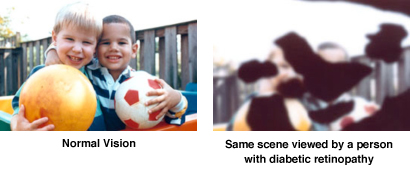

The laser beam can used to create small burns in areas of the retina with abnormal blood vessels to seal the leaks. Laser treatment is often used to treat diabetic retinopathy. Reasons for loss of vision are diabetic maculopathy and complications of proliferative diabetic retinopathy (PDR) such as vitreous hemorrhage, tractional retinal detachment, and neovascular glaucoma. What it’s like to see with diabetic retinopathy How is Diabetic Retinopathy Treated?ĭiabetic Retinopathy is not curable, but it can be treated to slow progression. Diabetic retinopathy is a potentially blinding complication of diabetes mellitus. Some studies show that controlling diabetes slows the worsening of diabetic retinopathy. This is the only way to diagnose diabetic retinopathy and catch it in its early stages. Because there are often no symptoms in the early stages of diabetic retinopathy, patients with diabetes should have an eye exam every year, where the eye doctor will screen for diabetic retinopathy. Vision lost to diabetic retinopathy is irreversible, but early detection and treatment can reduce the risk of blindness by 95 percent. When your blood sugar gets too high, it can damage the blood. Is Diabetic Retinopathy Preventable?ĭiabetic retinopathy is preventable with good blood sugar control. If you have diabetes, you probably know that your body cant use or store sugar properly.

Blindness may be avoided If the DR disease is detected. Proliferative diabetic retinopathy causes visual loss. In the most advanced stage of diabetic retinopathy, new abnormal blood vessels begin to grow on the surface of the retina, which can lead to scarring and cell loss in the retina. Diabetic Retinopathy (DR) is a disease that damages the retina of the human eye due to diabetic complications, resulting in a loss of vision. PDR may cause more severe vision loss than NPDR because it can affect both central and peripheral vision. Diabetic retinopathy causes tiny blood vessels in the retina to leak fluid or bleed, distorting vision. The retina detects light and converts it to signals sent through the optic nerve to the brain. This damages the tiny blood vessels in the retina. 40 to 45 percent of Americans with diabetes have some stage of diabetic retinopathy.ĭiabetic retinopathy is a condition caused by chronically high blood sugar. Diagnosis Treatment Prevention Other complications When to see a doctor Takeaway Diabetic retinopathy is an eye disease that affects people living with diabetes. Diabetes can affect your eye care, making it especially important to get a regular eye exam. Risk increases the longer a person has diabetes. Diabetic retinopathy is an eye disease caused by diabetes. People with all types of diabetes (type 1, type 2, and gestational) are at risk for diabetic retinopathy. Diabetic patients are more likely to develop glaucoma, cataracts, and are also susceptible to diseases such as diabetic macular edema and diabetic retinopathy. Diabetic patients are often at extra risk when it comes to eye problems.


 0 kommentar(er)
0 kommentar(er)
